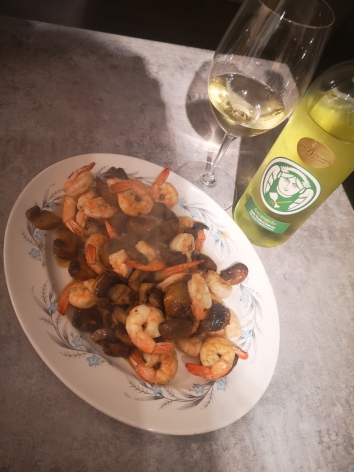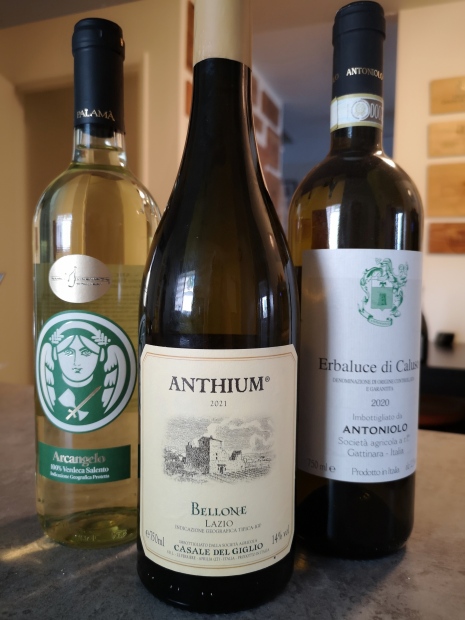This month for our #ItalianFWT, I threw out the gauntlet for our group to explore as many Italian white wines made with native grapes as possible. I live and work in a market where a plethora of wines are available and with that in mind, I’m sharing some wines this month that many have perhaps not tasted, let alone even heard of, so I hope you can live vicariously through my tasting notes! All wines featured are from family owned wineries, which is typically something I seek out: organic practices (even if they are not certified organic), hand harvesting and minimal intervention all make for good, clean wines that don’t leave you with a headache or feeling lethargic!
Erbaluce – if you’ve not yet been able to try this grape, you’re missing out! It is a high quality grape that can make not just still wines, but sparkling and sweet passito styles of wine. I’ve had the privilege of tasting all three on my very first visit to Vinitaly where my quest was to try as many wines made with native grapes as possible. I’m a grape geek so I made a plan, drew a map and was on my way. I visited Cieck which does make all three styles and it certainly was an eye opener.
The DOCG region of Caluso (Piemonte’s first DOC for white wine) is located in Northern Piemonte, close to Gattinara, which of course is famous for wines from Nebbiolo. Like many native grapes of Italy, names of the grapes are usually based on some type of characteristic. Erbaluce means “dawn’s light” as the grapes are very pale in colour when not fully ripened, likening them to a pale dawn light. With their thick skins and high acidity, this grape is ideal for both sweet and sparkling versions.
The third generation brother and sister duo Alberto & Lorella Antoniolo currently run the operation at ANTONIOLO SOCIETA’ AGRICOLA. Known mostly for the single vineyard Gattinara wines of nebbiolo, this erbaluce is no slouch and equally well-made! Bone-dry, exuberant, and oh so aromatic, the nose has pretty white flowers enhanced with flavors of stone fruit (apricots/peaches) and crisp citrus notes. Racy acidity, all ending with a clean, minerally finish. I decided to pair this with verdure griglia (grilled vegetables) sprinkled with herbed goat cheese for a bit of creaminess and sharp flavour. Simple, but oh so delicious! (or skip the goat cheese!)
Verdeca– this little known white grape from Salento in Puglia, is named after the green color of its berries (verde= green in Italian). This wine just reminds me of summer, blue sky, sand, and copious amount of sunshine! I certainly can’t spend lots of time in the hot sun but I sure do love its attributes! Sunshine just makes me happy as I’m sure it does many others! There’s plenty of sun in Puglia and even with the heat, this grape maintains its high acidity. Although its true origins are not known, I’ll bet this little grape hasn’t moved around much. It seems to really like the climate and terroir of Puglia. 
The Palamà family is famous in the Salento region as restaurateurs originally, only making their wine to serve in their own restaurant. Now run by 3rd and 4th generation Nini and Michele, they aim to keep their wines poised and restrained. This verdeca is named after Nini’s father Arcangelo who was known as a larger than life character and to whom Nini says “taught me everything “.
The wine is fresh and crisp with citrus notes, green apple, white flowers and fresh herbs all wrapped up in crisp acidity and salinity. This wine is just FUN and at only 12% abv, I might be drinking an embarrassing amount of it this summer. This wine was begging for seafood, or in my case shrimp, sauteed in olive oil and butter along with mini portabellas. The herbs on the shrimp brought out the hidden herbs of the verdeca.
Bellone – This quality grape from Lazio is something I love to sell! Often full(-er) bodied with notes remeniscent of Chardonnay, it’s easy to sway lovers of the international grape towards this Italian native. This magical grape has been around since before the Roman times, is also multi-functional: it can be made into sweet wines, since it often suffers from botrytis (noble rot), along with the traditional still wines. It’s actually pretty rare, yet a few good examples can be found and found HERE in my market! I also happen to love this particular grape variety and Casale del Giglio offers an amazing bottle of wine for under $20! In an area where grape growing was non-existent, this family owned winery has taken full advantage of the rich, sandy, and partly volcanic soils along with hot summer temperatures, and mild, rainy winter months, which provide optimal conditions for viticulture. Throw in some mild seabreezes and great diurnal range for even greater optimization!
 They also have a vineyard with 60-year-old vines that they use to make the Anthium. The extra $11 is worth it for gorgeous full bodied and concentrated wine. Beautiful tropical fruit flavours of mango, papaya, along with yellow apple and hints of honey along with nuances of spice; finished with a little salinity due to the vineyards proximity to the sea. As this was the fullest bodied wine of the three whites, it was meant to go with the meal in its entirety: Chicken cordon bleu (my version made with provolone and rosemary ham), lemon and dill penne, grilled vegetables and sauteed shrimp and mushrooms. Epic. In fact I had a hard time deciding which wine went with the meal overall!
They also have a vineyard with 60-year-old vines that they use to make the Anthium. The extra $11 is worth it for gorgeous full bodied and concentrated wine. Beautiful tropical fruit flavours of mango, papaya, along with yellow apple and hints of honey along with nuances of spice; finished with a little salinity due to the vineyards proximity to the sea. As this was the fullest bodied wine of the three whites, it was meant to go with the meal in its entirety: Chicken cordon bleu (my version made with provolone and rosemary ham), lemon and dill penne, grilled vegetables and sauteed shrimp and mushrooms. Epic. In fact I had a hard time deciding which wine went with the meal overall!
June is my birth month, and I always take my actual birthday off work. Since it’s on a Sunday this year, I don’t really need to worry about the day off, but I AM taking the entire weekend, and it shall be full of food and wine! I look forward to “eating and drinking vicariously” with some of Italy’s other native whites, through all my fellow #ItalianFWT bloggers! If you’re as curious as me, head over to their blogs and read those too! Then join us for our Twitter chat on Saturday June 4 at 9 am MDT/11am EDT as I will be hosting our discussion on white wines of Italy. Join the conversation by following and using the hashtag #ItalianFWT. I’m sure we will discuss this topic with great enthusiasm!
-
-
- A Day in the Life on the Farm takes Another Trip to Orvieto to Enjoy Dessert
- Crushed Grape Chronicles is Dreaming of Lake Garda with a wine from Lugana
- Culinary Adventures with Camilla shares Pasta al Tartufo + Terredora di Paolo Fiano di Avellino 2019
- Gwendolyn Alley Wine Predator is Discovering Rare Italian White Grapes Plus Pairings
- My Full Wine Glass discusses Greco di Tufo from the rich volcanic and clay soils of Campania
- Avvinare shares white wines from Lazio
- Grapevine Adventures talks about How Aging Maximises the Unique Characters of Trebbiano Spoletino
- Grape Experiences spends “A Southern Italian Afternoon: Greco di Tufo Feudi di San Gregorio 2020 with Spaghetti Pomodoro”
-
Salute!


Pingback: How Aging Maximises the Unique Characters of Trebbiano Spoletino - Grapevine Adventures
Pingback: Albana, Boschera, Erbaluce, Incrocio Bruni, Maceratino: Rare Italian White Grapes Plus Pairings #ItalianFWT | wine predator.............. gwendolyn alley
I have only tried Erbaluce. I can’t wait to try these wines and your pairings. Thanks for hosting, Marcia!
Pingback: Dreaming of Lake Garda with a wine from Lugana #ItalianFWT | Crushed Grape Chronicles
I have tasted Erbaluce but not Verdeca or Bellone. Italy has an abundant variety of indigenous grapes to discover!
Your pairings look delicious! The grilled vegetables with goat cheese with the Erbaluce sounds amazing!
One out of three, I need to get busy! Wishing you a super Bday weekend ;-D
What a great month of pairings. Happy Birthday to you!!!!!